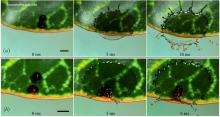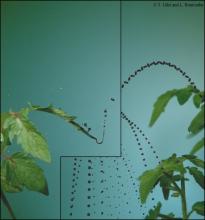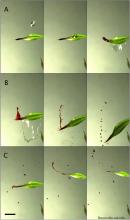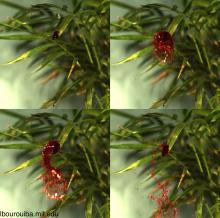Fluid Dynamics and Disease: Interfacial Flows and Plant Epidemiology
 |
Unsteady sheet fragmentation: from compliance, wetting, non-isolated drop impacts, to secondary drops and contamination |
Understanding what shapes the drop size distributions produced from fluid fragmentation is important for a range of industrial, natural and health processes. Fluid fragmentation plays an important role in pathogen transmission in particular. A particular example is from impacts on contaminated surfaces already, some dry, and others already wet, supporting sessile drops. These are ubiquitous in the field, where plant pathogens are attached to leaves via sticky mucilage requiring dissolution (e.g., spores of rust). The Crescent-moon fragmentation is one of the most efficient... more |
 |
Fluid fragmentation shapes rain-induced foliar disease transmission |
Plant diseases represent a growing threat to the global food supply. The factors contributing to pathogen transmission from plant to plant remain poorly understood. Statistical correlations between rainfalls and plant disease outbreaks were reported; however, the detailed mechanisms linking the two were relegated to a black box. In this combined experimental and theoretical study, we focus on the impact dynamics of raindrops on infected leaves, one drop at a time. We find that the deposition range of most of the pathogen-bearing droplets is constrained by a hydrodynamical condition and we... more |
 |
Rain-induced foliar pathogen ejection |
Plant diseases are a major cause of losses of crops worldwide. Although rainfalls and foliar disease outbreaks are correlated, the detailed mechanism explaining their link remains poorly understood. The common assumption from phytopathology for such link is that a splash is generated upon impact of raindrops on contaminated liquid films coating sick leaves. We examine this assumption using direct high-speed visualizations of the interactions of raindrops and leaves over a range of plants. We show that films are seldom found on the surface of common leaves. We quantify the leaf- surface’s... more |
 |
Surface-tension phenomena in organismal biology: plants |
Flows driven by surface tension are both ubiquitous and diverse, involving the drinking of birds and bees, the flow of xylem in plants, the impact of raindrops on animals, respiration in humans, and the transmission of diseases in plants and animals, including humans. The fundamental physical principles underlying such flows provide a unifying framework to interpret the adaptations of the microorganisms, animals, and plants that rely upon them. The symposium on ‘‘Surface-Tension Phenomena in Organismal Biology’’ assembled an interdisciplinary group of researchers to address a large... more |
